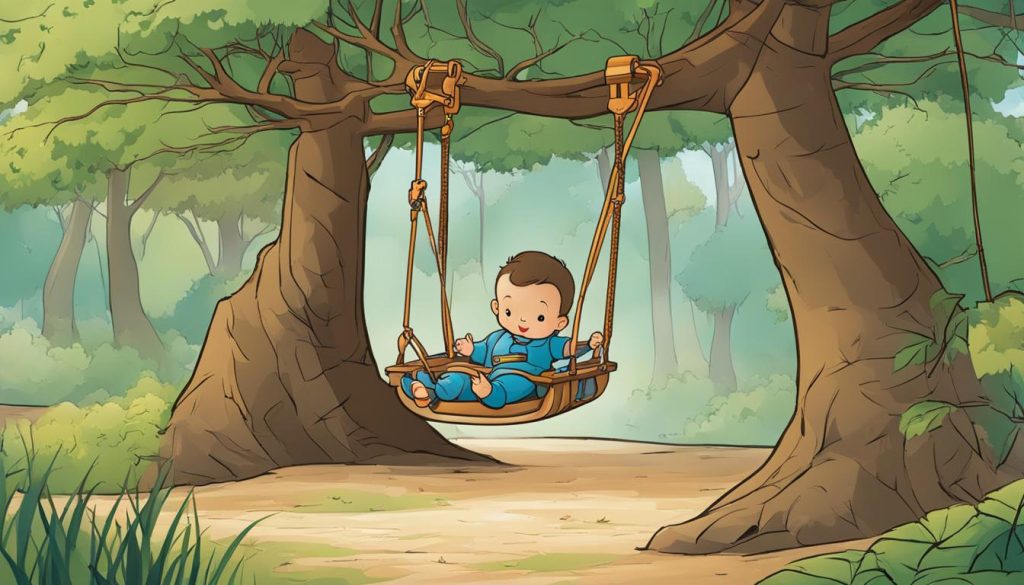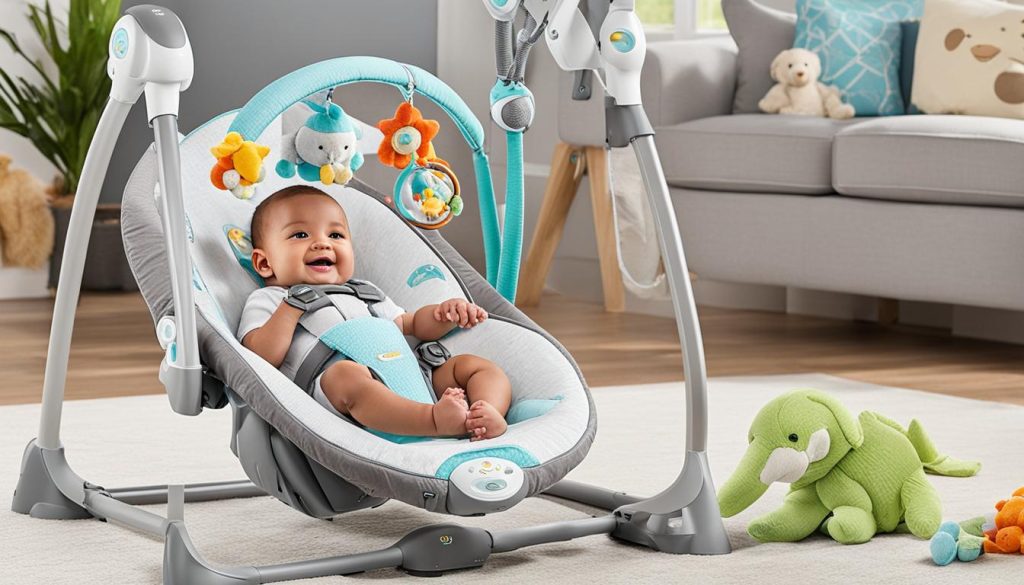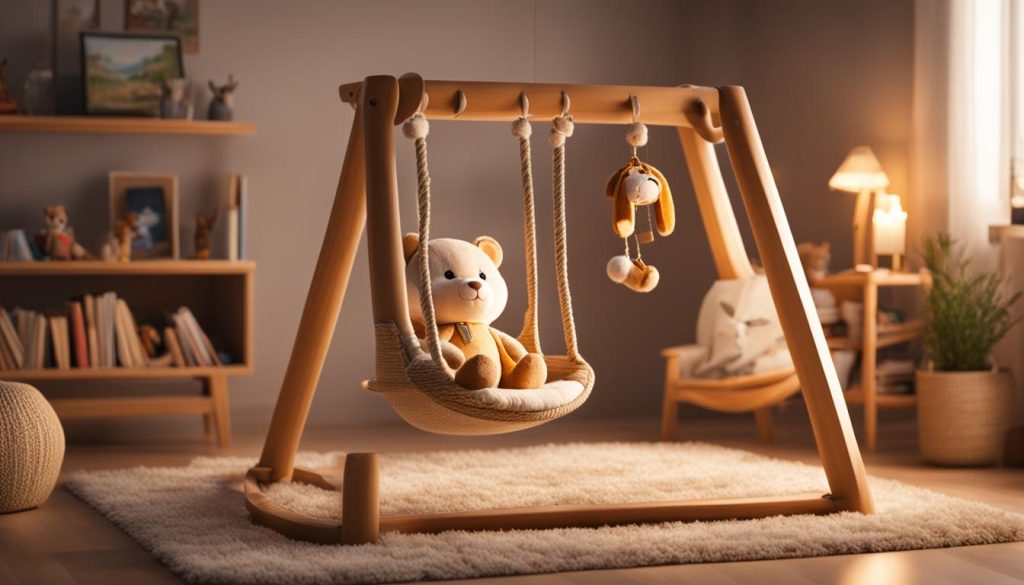As a parent, ensuring the safety of our little ones is our top priority. When it comes to baby swings, it’s important to understand the basics and follow proper guidelines to keep our babies safe and secure. In this article, I will discuss the safety concerns associated with baby swings and provide you with essential guidelines to ensure your baby’s well-being while using a swing.
One common question that parents ask is, “Are baby swings safe?”. While baby swings can be a great tool for soothing and entertaining infants, they are not designed for sleep. It is important to note that experts do not recommend letting babies sleep in a swing due to the risks of injury, blocked airways, accidental suffocation, and even death.
When babies sleep in a swing, they are in a sitting position which is not safe for prolonged sleep. It can result in difficulty breathing as young infants have a harder time breathing when sitting upright. The tilted surface of the swing can also increase the risk of rolling onto the stomach, which is a preventable risk factor for Sudden Infant Death Syndrome (SIDS).
Another concern is the pressure on the back of the baby’s head, which can lead to flat spots. To ensure baby swing safety, it is crucial to limit the time babies spend in swings, properly buckle the straps, and avoid using cushions or soft bedding.
By following the manufacturer’s recommendations, ensuring stability, and checking for Consumer Product Safety Commission (CPSC) standards, we can provide a safe environment for our little ones while using baby swings. Stay tuned for the next sections, where I will discuss the benefits of using baby swings and different types of baby swings and their features.
The Benefits of Using Baby Swings
Baby swings provide a soothing and entertaining experience for infants. The gentle motion and vibrations of a swing mimic the environment of the womb, which can help to calm fussy babies and promote better sleep. The swinging motion supports motor and cognitive development by promoting balance, rhythm, spatial awareness, and muscle control. Baby swings can also be helpful for managing symptoms of acid reflux in infants. However, it is important to note that not all babies may enjoy or find comfort in a swing, and some may become overstimulated by the motion and sounds. It is recommended to try different settings and observe your baby’s response to determine if a swing is suitable for them.
Using a baby swing can provide a much-needed break for parents, allowing them to attend to other tasks while still keeping their infant soothed and entertained. The swinging motion of a baby swing can lull infants to sleep, making it a useful tool for naptime or bedtime routines. The gentle movement can also provide a comforting sensation for babies who may be experiencing fussiness or colic. In addition to soothing and calming babies, swings can also provide visual stimulation through attached mobiles or toys, encouraging the development of their senses and motor skills.
Baby swings can be especially beneficial for parents who may have difficulty soothing their baby through traditional methods. The combination of the swinging motion, soothing sounds or music, and visual stimulation can create a calming and engaging environment for infants. The ability to adjust the swing’s speed and motion settings allows parents to customize the experience to their baby’s preferences. However, it is important to remember that each baby is unique, and what works for one may not work for another. It is essential to closely monitor your baby’s reactions and adjust the swing’s settings accordingly to ensure their comfort and safety.
Benefits of Using Baby Swings:
- Provides a soothing and calming environment, mimicking the motion and sensations of the womb
- Promotes motor and cognitive development through balance, rhythm, and spatial awareness
- Helps manage symptoms of acid reflux in infants
- Offers a break for parents while still keeping their baby entertained and soothed
- Encourages visual stimulation and the development of senses and motor skills
- Provides a customizable experience with adjustable speed and motion settings
While baby swings can offer benefits in terms of soothing and entertaining infants, it is important to use them responsibly and in accordance with safety guidelines. Section 4 will provide recommendations for safe baby swing usage to ensure the well-being of your baby.
Different Types of Baby Swings and Their Features
When it comes to baby swings, there are various types available on the market, each with its own unique features and benefits. Understanding the different types can help you make an informed decision when choosing the right baby swing for your little one.
Full-Sized Swings
Full-sized swings are larger and offer a wide range of features, including multiple swing speeds, music, and toy attachments. They provide durability and stability but require more space in your home. These swings are a great option if you have a dedicated area for your baby’s swing and want all the bells and whistles.
Portable Swings
Portable swings, on the other hand, are smaller and lightweight, making them easy to fold and transport. They are ideal for families on the go or for those who have limited space. Portable swings usually offer fewer features but still provide a comfortable and soothing experience for your baby.
Glider Swings, Bouncer Swings, and Rocker Swings
Glider swings provide a gentle horizontal motion, while bouncer swings add bouncing motions to the swing experience. Rocker swings offer the versatility of both rocking and swinging motions, allowing you to choose the one that your baby prefers.
Cradle Swings
Cradle swings are designed to provide a cozy and secure sleep environment for your baby. They often come with a reclining seat and gentle swinging motions, promoting relaxation and comfort.
Combination Swings and Outdoor Swings
Combination swings offer multiple functionalities, such as converting from a swing to a bouncer or rocker. These versatile swings grow with your baby and provide various options for entertainment and soothing. Outdoor swings, on the other hand, are built to withstand outdoor conditions and are suitable for older babies and toddlers.
When choosing a baby swing, it’s essential to consider factors such as space availability, build quality, comfort, safety features, seat recline options, power source, and ease of assembly and usage. Additionally, it’s always a good idea to follow manufacturer recommendations and ensure that the swing meets safety regulations to provide a secure and enjoyable experience for your baby.
| Type of Baby Swing | Features |
|---|---|
| Full-Sized Swing | Multiple swing speeds, music, toy attachments, durability, stability |
| Portable Swing | Compact, lightweight, easy to fold and transport |
| Glider Swing | Gentle horizontal motion |
| Bouncer Swing | Bouncing motions |
| Rocker Swing | Rocking and swinging motions |
| Cradle Swing | Cozy sleep environment, reclining seat |
| Combination Swing | Multiple functionalities, versatility |
| Outdoor Swing | Designed for outdoor use, suitable for older babies and toddlers |
Recommendations for Safe Baby Swing Usage
When it comes to using a baby swing, safety should be the top priority. By following these recommended tips, you can ensure that your baby remains safe and secure while enjoying the benefits of a swing:
Choose a Safe Baby Swing
When selecting a baby swing, opt for models that meet safety standards and guidelines. Look for features such as safety harness belts, non-slip bases, and sturdy construction. It’s also essential to check for any recalls and make sure that the swing complies with safety regulations.
Properly Assemble and Position the Swing
Take the time to assemble the swing correctly, following the manufacturer’s instructions. Ensure that all parts are securely fastened, and there are no sharp edges or corners. Additionally, position the swing on a stable and flat surface to prevent any tipping or toppling accidents.
Use Safety Straps and Keep an Eye on Your Baby
Always buckle your baby securely into the swing using the provided safety straps. This will prevent them from falling out or sliding down. It’s crucial to never leave your baby unattended while in the swing and keep a close eye on them at all times.
Follow Age and Weight Recommendations
Pay attention to the age and weight recommendations provided by the manufacturer. Once your baby exceeds these limits, it’s time to transition them out of the swing. Continuing to use a swing that is not suited for their size can pose safety risks.
Avoid Placing the Swing on Elevated Surfaces
Never position the swing on elevated surfaces such as tables or countertops. This can increase the risk of falls and serious injuries. Keep the swing on the floor or a secure, flat surface to ensure your baby’s safety.
Remember, a baby swing should not replace a crib or bassinet for sleep.
While a swing can be a helpful tool for soothing and entertainment, it’s important to prioritize safe sleep practices. Babies should always sleep on their backs in a crib or bassinet on a flat surface to reduce the risk of SIDS. Use the swing for supervised playtime or to soothe your baby, but always prioritize safe sleep in an appropriate sleeping space.
By following these recommendations, you can ensure that your baby enjoys the benefits of a swing while staying safe and secure. Remember to always prioritize your baby’s well-being and provide a balanced approach to their soothing and entertainment needs.
Potential Risks and Pitfalls of Using Baby Swings
While baby swings can be beneficial, it is important to be aware of potential risks and pitfalls. Some babies may not enjoy or find comfort in a swing, and it is important to respect their preferences. Over-reliance on a swing for soothing can prevent parents from exploring other soothing techniques, so it is recommended to vary baby soothing techniques. The Academy of American Pediatrics emphasizes the importance of daily tummy time for infants’ development and cautions against prolonged use of swings or infant seats that can cause flattening of the baby’s head. Using a swing in an unsafe manner, such as placing it on an elevated surface or leaving the baby unattended, can also pose risks. It is crucial to prioritize safety and choose swings that meet safety standards, read manufacturer guidelines, and ensure proper usage.
When using a baby swing, it is important to be mindful of the following risks and take necessary precautions:
- Not all babies may enjoy or find comfort in a swing, so it is important to respect their preferences and explore other soothing techniques.
- Over-reliance on a swing for soothing may hinder the exploration of other techniques, so it is recommended to vary baby soothing techniques.
- Prolonged use of swings or infant seats can lead to flattening of the baby’s head, so it is important to ensure that babies have regular tummy time for healthy development.
- Placing the swing on an elevated surface or leaving the baby unattended can pose risks, so it is crucial to prioritize safety and use the swing in a safe manner.
- Choose swings that meet safety standards, carefully read manufacturer guidelines, and ensure proper usage to prevent accidents and injuries.
By being aware of these potential risks and pitfalls, parents can make informed decisions about using baby swings and take necessary precautions to ensure their baby’s safety and well-being.
| Risks | Pitfalls |
|---|---|
| Some babies may not enjoy or find comfort in a swing | Over-reliance on a swing for soothing |
| Prolonged use of swings or infant seats can cause flattening of the baby’s head | Unsafe use of swings (e.g., placing on elevated surface, leaving baby unattended) |
| Choosing a swing that doesn’t meet safety standards |
The Importance of a Balanced Approach to Baby Soothing
When it comes to soothing your baby, baby swings can be a helpful tool. However, it’s important to maintain a balanced approach to ensure your baby’s safety and healthy development. While baby swings provide soothing and entertainment, they should not be relied upon excessively.
It is crucial to explore a variety of activities for your baby’s physical, cognitive, and social development. Engaging in different experiences and soothing techniques can support their overall well-being. Instead of relying solely on a swing for sleep, gradually introduce sleeping in a crib or bassinet when your baby is sleepy but still awake. This helps them develop healthy sleep habits and reduces dependency on the swing.
If your baby continues to have difficulties falling asleep without a swing, it’s advisable to consult a healthcare professional for guidance. They can provide suggestions and support to help your baby transition to sleeping without relying on the swing.
By maintaining a balanced approach to baby soothing, you can ensure the safety of your baby and promote their healthy development. Remember, there are various safe baby swing options available, but it’s important to use them in moderation and provide a range of experiences for your little one.





